With modern technology, marketers and brands hold a wealth of information at their fingertips when it comes to measuring the success of their advertising campaigns. Although not traditional and relatively new, measuring a Fake Out of Home or FOOH ad success is no exception.
After all, if you do it right, FOOH ads can be a powerful tool in any marketer's toolbox. It can bring you a whopping number of impressions and engagement and get people talking about your brand.
But what exactly is a FOOH ad? And, how do you know if your FOOH ad campaign is delivering the results you want? This guide will explore 29 essential metrics and tips to help you measure and improve your FOOH ad success. Let's take a look.
Want to know everything there is to know about Fake Out of Home ads? Check our 2024 guide here.

Fake Out of Home, or FOOH, is a type of short-form video advertising that combines CG 3D elements with real-life footage of popular locations and landmarks. You'll often see these ads on TikTok, Instagram or Meta reels, and YouTube dhorts.
When done right, Fake Out of Home ads (when done right) create such a seamless blend of the real and the 3D elements that you'll often see a barrage of online comments asking, "Chat, is this real?"(It's not.) Sometimes, the disbelief and absurdity are so out of this world that even news outlets will pick up on these ads, not realizing it's a marketing ploy.
Just take a look at this FOOH ad from Volvo Austria. A car is being driven out of an underground freeway, where it appears in a garage that seems to be installed on the wall of a second-story building. People were asking our team at Rendersnek how long this installation would be up in Vienna!
Another similar thing happened with our FOOH ad for Vapiano Austria. A marketing department from another company actually called Vapiano and inquired how much it would cost to hang the noodles on a building's facade—as if it were a real thing.
Got a question about Fake Out of Home ads or have an idea you want to pitch? Contact us and let's make it happen.
The absurdity and shock factor these ads can create makes them so effective. They stop people in their scrolling tracks, getting them to pause and engage with the content. And big brands are well aware of this, too, which is why you've seen them jumping on the hype train and seeing FOOH ad success in recent years.
Fake Out of Home is the future of advertising, and here are 5 top reasons why this trend is here to stay and why you should care if you're a marketer or advertiser.

Marketing campaigns take work, and marketers and brands know that. From its conception to the execution of each ad, every piece is carefully curated to fit the brand's specific purpose and goal. And planning your campaign and FOOH ad success are no different.
Before launching your FOOH campaign, it is crucial to identify your primary objectives and how FOOH ad success is supposed to look for your business. Do you want to raise brand awareness? Increase social media engagement and followers? Or generate leads for your business?
Once you've set what you want to achieve, it's time to make those goals SMART. Specific, Measurable, Achievable, Relevant, and Time-bound. For example:

KPIs are essential for measuring the success of any marketing campaign. They help you understand what's working and what needs improvement in your campaign, which is crucial for measuring FOOH ad success. KPIs also provide valuable insights into your target audience and their behavior, giving you the information you need to optimize your campaign for better performance.
Depending on which platform you use for your FOOH ads, some of the metrics will be available to measure directly from the platform's analytics dashboard. For others, you may need to use third-party tools or manual calculations to track these metrics.
Here are 16 key metrics that you should consider when measuring FOOH ad success:
The lead generation rate is the percentage of people who view your ad and take action. This could mean clicking a unique link to your website or filling out a form.
Tracking leads generated from your ad is an excellent way to measure the FOOH ad success in generating potential customers for your business. Because this metric is more specific to your business goals, it can give you a better understanding of the impact of your FOOH ad campaign.
Apart from lead generation, you should also track the overall conversion rate of your FOOH ad. This measures the percentage of viewers who take a desired action, such as making a purchase or signing up for a service.
Here's an example: If your marketing campaign's goal received 100 new leads, but none of them converted into customers, then it may be time to tweak your ad. Your FOOH ad may have received interest, but its message may haven't resonated with your target audience.
Want to know what makes a FOOH ad successful? Read our: 5 Top Tips on Avoiding Common Fake Out of Home Ad Mistakes to learn more.
The cost per lead is the amount of money you spend to generate one lead. For example, if your FOOH ad campaign costs $100 and generates 50 leads, then your cost per lead is $2. This metric helps you determine the efficiency of your marketing efforts and can guide future budget allocations.
Another important metric to consider when measuring FOOH ad success, the CPA is the average cost you spend to acquire a new customer. This includes all the costs associated with your FOOH campaign, including ad creation, ad placement fees, and additional expenses. A lower CPA indicates higher efficiency in acquiring new customers through your marketing efforts.
Engagement is a crucial aspect of FOOH ad success. The more people talk about your ad, the better its reach and potential impact.
Tracking likes, shares, and comments on social media platforms like TikTok, Meta, and Instagram can show how well your ad resonates with your viewers and target audience. This metric can also help you identify any changes or updates that could improve the engagement on your FOOH ad.
How many people watch your entire FOOH ad? Do people skip it after a few seconds, or do they watch until the end?
Tracking your video completion rate can give you insight into how effective the content of your FOOH ad is. If your completion rate is low, meaning people aren't watching your whole ad, that can tell you that your hook might be strong, but your ad's middle, end, and overall message may need improvement.
Here's a guide on How to make effective and viral FOOH ads that sell.
Simply put, the CTR is the percentage of viewers who clicked on your ad. This metric can show how well your FOOH ad persuades people to take action, whether it's to visit your website or download an app.
How many people are talking about your brand after seeing your FOOH ad? Tracking mentions and hashtags related to your ad will let you know how well it's resonating with viewers and if it's creating any sort of dialogue or conversation online.
Unique reach refers to the number of individuals who saw your ad at least once. This metric can show how many people were exposed to your brand through your FOOH ad campaign.
Similar to unique reach, impressions measure the total number of times your ad was shown, including multiple views by the same person. This metric is useful for understanding the overall exposure and potential impact of the FOOH ad success.
Knowing how many people visited your website after seeing your FOOH ad can give you an idea of its effectiveness in driving traffic, especially if your goal is to increase brand awareness and website visits.
You can track this using unique links or landing pages specific to your ad campaign. This will also help you identify which platforms or channels drive the most traffic to your website.
The bounce rate measures the percentage of people leaving your website after viewing only one page. A high bounce rate could indicate that your FOOH ad isn't effectively targeting the right audience or that your website needs improvement.
Knowing where your website traffic is coming from can help you determine if your FOOH ad is effectively reaching your desired audience. If a huge portion of your traffic isn't coming from social media -- where your ad is placed, it may be time to rethink the messaging or content of your FOOH ad.
Tracking this metric means examining the number of times your brand was mentioned before and after the launch of your FOOH ad campaign. This could include social media mentions and tags, articles, news stories that feature your brand, or customer feedback.
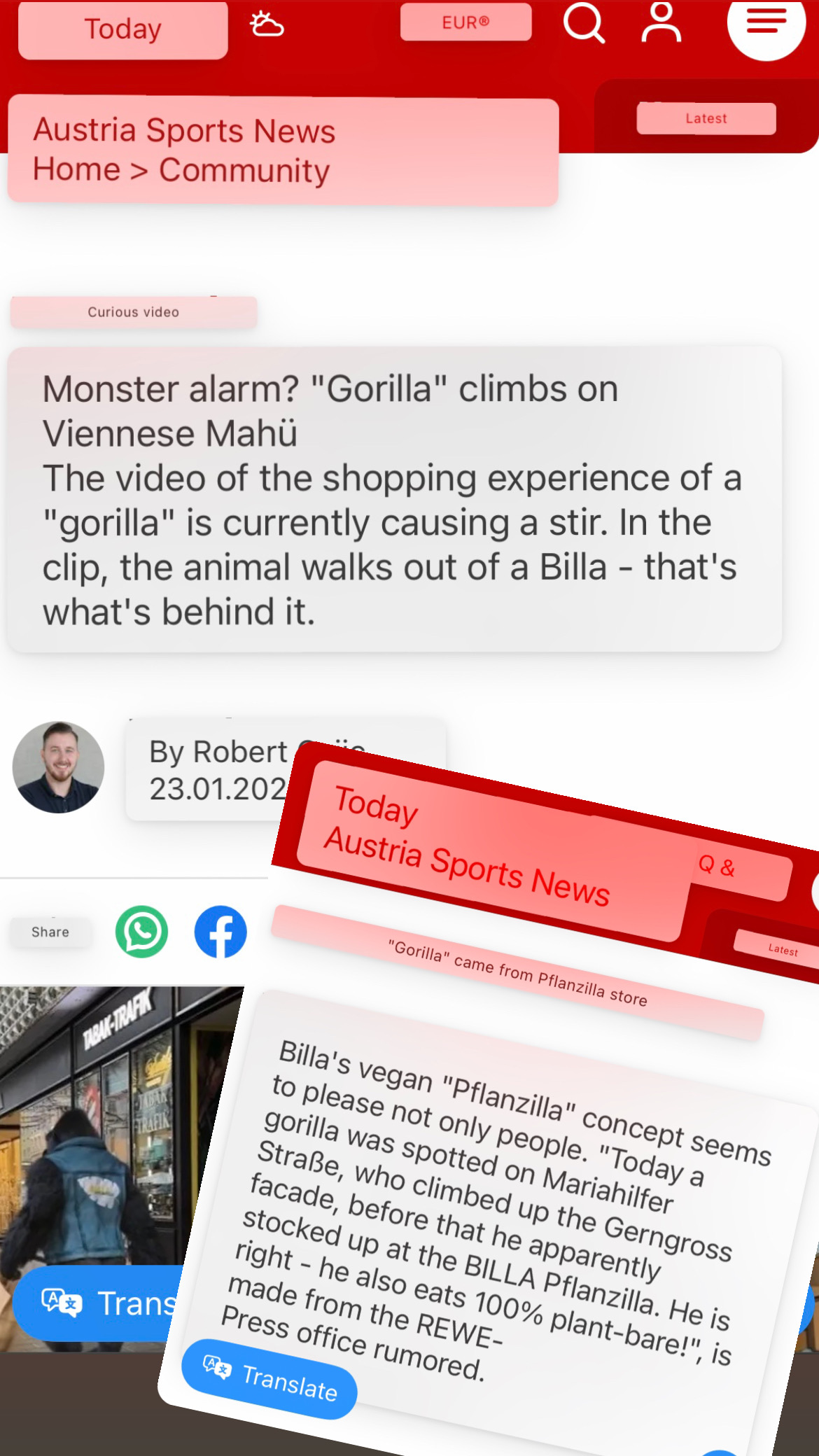
Brand sentiment refers to people's overall attitude towards your brand. Look at the comments and feedback on your FOOH ad to understand how people perceive your brand.
How do people respond to your ad? Are they excited, intrigued, or uninterested? This metric will help you gain insights into how the FOOH ad success is impacting brand perception and if it aligns with your overall branding strategy.
This metric measures the number of people searching for your brand, another critical indicator of FOOH ad success. This metric is worth tracking if your top goal is to increase brand awareness and recognition.
You can track branded search volume through Google Trends or other analytics tools and compare it to the time period before your FOOH ad campaign. An increase in branded searches suggests that your ad has successfully increased brand awareness among your target audience.

Knowing the right tools to track your KPIs is crucial in measuring FOOH ad success. You can make informed decisions and adjustments to your campaign based on data-driven insights, and avoid making calls that could potentially harm your return on investment.
Here are 13 tools you can use to measure your FOOH ad success:
This all-in-one tool is a must-have for tracking website traffic, bounce rate, and traffic sources. The platform offers in-depth data and analytics on website unique visitors, conversions, viewers, and how the FOOH ad success impacts your website's overall traffic.
A great feature of this analytics tool is the ability to set up custom goals and track specific actions that align with your brand and FOOH ad campaign's objectives. For example, if the goal of your campaign is to increase conversions and drive more sales, you can set up a goal for each completed purchase and track the number of conversions from your FOOH ad campaign.
FOOH ads are placed on social media, and Instagram is one, if not the most popular choice of platform for this type of advertising. Using Instagram's built-in insights, you can track how many people saw, liked, commented, shared, or bookmarked your FOOH ad post.
You can also see how many people interact with your profile after they see your ad. If your goal is to increase brand awareness as part of your marketing campiagn, this tool can be valuable in tracking your progress and FOOH ad success.
Another popular option, Meta's ads manager, is a great tool for tracking FOOH ad success on Facebook and Instagram. This is a fantastic tool, especially if your target audience is on Meta, as it offers in-depth data on reach, impressions, CTR, and engagement metrics like comments and shares.
Another useful feature of this tool is the ability to create custom audiences based on location, demographics, interests, behaviors, etc. This allows for better targeting of your FOOH ads to reach the right audience.
TikTok has become an increasingly popular advertising platform, and its short video format aligns perfectly with the nature of FOOH ads. Its analytics dashboard tracks views, likes, shares, comments, and audience demographics for your FOOH ads.
However, it is important to note that if you post your FOOH ad on TikTok, it's not recommended that you do so anywhere else. TikTok's algorithm favors new and unique content, so posting the same ad on multiple platforms may result in lower engagement, so make sure your target audience is primarily on TikTok.
A platform that also allows you to schedule and publish posts, Hootsuite's Analyze feature provides insights into major social media platforms like LinkedIn, X, Meta Pages, YouTube, and Instagram. This tool also offers a unique feature to track FOOH ad success: impact metric.
This metric provides insights into each social media post's return on investment (ROI), including FOOH ads. You can see how much revenue or conversions your ad generated compared to the cost of running it and track the overall impact of your FOOH campaign.
If you're a marketer or agency running a campaign for a client or brand, their feedback is also crucial in evaluating FOOH ad success. After all, they probably know most about their brand, target audience, and goals.
Make sure to communicate regularly with your clients and gather their direct feedback on the FOOH ad sucess. Schedule regular check-ins with your clients to discuss campaign progress, goals, and any concerns they may have.
Your client's satisfaction with the ad campaign will open your eyes to areas for improvement and ultimately lead to success. It also allows for open communication and collaboration between marketer and client, resulting in a stronger partnership and potentially more successful future campaigns together.
Sprout Social offers a comprehensive social media report for your marketing campaign. This platform allows you to compare how your posts are performing to a competition's, and it can also show you if FOOH ad success is on the horizon. It also allows you to view which campaign, whether it's a contest or a promotion of a new line, impacted your brand awareness the most.
Rival IQ is an all-in-one social media analytics software that can compare your performance and your competitors' FOOH ad success rate across multiple platforms, such as Facebook, Twitter, and Instagram. This tool also provides insights into your audience demographics and engagement rates.
Brandwatch is an analytics tool that helps you understand how your brand is perceived online in real-time. This sophisticated platform can track conversations, mentions, sentiment, and overall reach on various social media platforms, blogs, and articles about your FOOH ad.
Brandwatch also offers you key insights into which influencers might be talking about your campaign. This allows you to identify and potentially collaborate with them to increase FOOH ad success in future campaigns.
SEMrush is a marketing analytics tool that tracks your website's performance regarding organic and paid search traffic. You can also use this platform to monitor your competitors' FOOH ad success rate, keywords, and budget for each campaign.
This advanced tool also offers insights into your website's SEO and content strategy, like backlink analysis and keyword rankings. These insights can help you optimize your website for better performance.
Gathering feedback from your target audience is an important aspect of measuring FOOH ad success. SurveyMonkey allows you to design and conduct surveys to gather information on what people think about your ad campaign if it resonated with them, and how it impacted their perception of your brand.
SurveyMonkey also offers a Net Promoter Score (NPS) feature, which measures customer loyalty and satisfaction. This can be valuable in understanding if your FOOH ad campaign effectively increases brand loyalty for your target audience.
Mention is another social listening tool that helps you track brand mentions across various platforms in real time. It can help you monitor the impact of your campaign on social media and overall FOOH ad success, and it allows you to engage with potential customers or address any negative mentions.
This tool also offers insights into sentiment analysis, popular hashtags related to your brand, and geographic location of mentions and compares them to your competitors. These insights can help you make data-driven decisions for future FOOH ad campaigns.
Buzz Sumo is a content marketing tool that helps you analyze your content's performance and identify top-performing topics, keywords, and influencers in your industry. It can also track social media shares related to your FOOH ad campaign, giving you insights into what content resonates with your audience.
This tool also offers competitor analysis and allows for content ideation based on popular trends and keywords related to your niche or industry. These insights can help you create more impactful campaigns and content and guarantee future FOOH ad success.
As the digital landscape continues to evolve, knowing what data to track and how to analyze it is crucial in measuring the FOOH ad success. Even if you don't see success from your numbers right away, these tools and strategies can help you optimize future campaigns for maximum impact.
Constantly measuring and analyzing data can provide valuable insights into your target audience's behavior and preferences, allowing you to create more effective FOOH ad campaigns that resonate with them.
With time, fine-tuning of your campaign, and consistent analytics monitoring, you can stay ahead of the curve and consistently drive success for your FOOH ad campaigns. So, stay informed, stay updated, and keep optimizing to achieve the best possible results.
Got an idea for a FOOH campaign or interested in implementing one for your brand? Connect with us today and let's make it happen.
2023 was quite a year for "Fake Out of Home advertising" or "Fake OOH." This new form of advertising quickly gained traction over the past year, especially among fashion and lifestyle brands, and has been the talk of marketing circles ever since.
FOOH ads have been taking the advertising industry by storm, but what exactly does it mean?
The wording for this new-age marketing has yet to be 100% defined. Mixed Reality Videos, Augmented Reality Videos, Virtual Reality Videos, Fake Ads, CG Ads, and CG Marketing are some of the terms used to describe it.
Essentially, Fake Out of Home is a form of advertising that combines computer-generated imagery (CGI) and real video footage to create an illusion of an immersive, short-form ad that appears as if it is taking place in a real-world location.
These ads are then shared on social media platforms, such as Instagram and TikTok, to reach a larger audience. Let's explore what FOOH ads are and why you should care about them.
Fake OOH advertisements, or as we like to call them, "Mixed Reality Videos," are compositions of real videos with computer-generated imagery (CGI). In summary: putting/tracking 3D objects in a conventional video.
In general, the use of CGI is nothing new; Hollywood has been doing that for quite some time already. In fact, the first feature film to use CGI was "Westworld" (1973), and the first film to ever use CGI was "Vertigo" (1958), a movie by Alfred Hitchcock. It was used in the film's opening credits.
If you want to know more about this new marketing trend, read our 2024 guide on everything you need to know about FOOH.
As you can see, CGI has been around for a long time; most of us just haven't noticed it. So, why is it such a big deal in the world of advertising now?
Fake Out of Home ads offer a unique and innovative way for brands to showcase their products or services. With the rise of social media and short-form content, these ads are perfectly suited to grab the attention of younger audiences constantly scrolling through their feeds.
Here are the top 5 benefits of using FOOH ads for your brand:
FOOH ads are short-form in nature. These ads can quickly rack up millions of views because of their entertainment (and often shock) value. Just look at Maybelline on Instagram, for example. Their typical content gets about 200,000 views on average, but their Fake Out of Home ads easily reach millions of views!
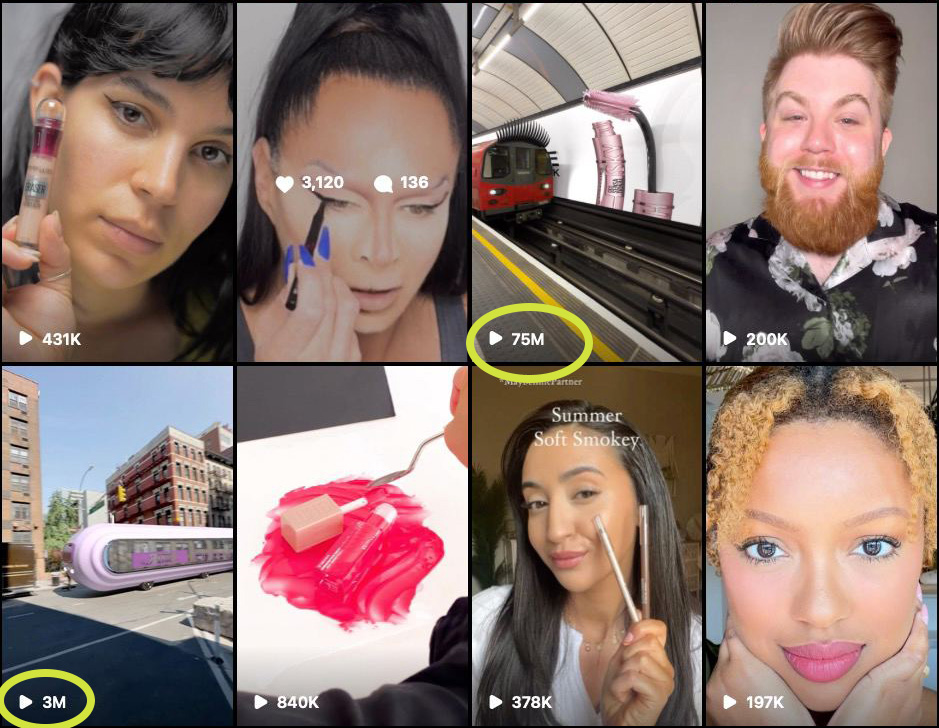
While the 8-minute attention span claim has been debunked (multiple times!), attention is still money. The true claim?[1] Good storytelling keeps people hooked for longer - the same reason people can binge-watch a TV series for hours.
And if showrunners can do that with hours, imagine what brands can do in just seconds!
With CGI or AR technology, the sky (or your budget) is the limit. Want life-sized versions of your products roaming the streets of New York for your campaign? No problem. Want to place a huge clothes line on top of the Statue of Liberty to showcase your new clothing line? Consider it done.
Just look at Jacquemus' Instagram page. It's filled with absurd and unconventional ads that showcase the brand's quirkiness and avant-garde fashion. These types of ads are only possible with Fake OOH technology. And, of course, they get millions of views, too.
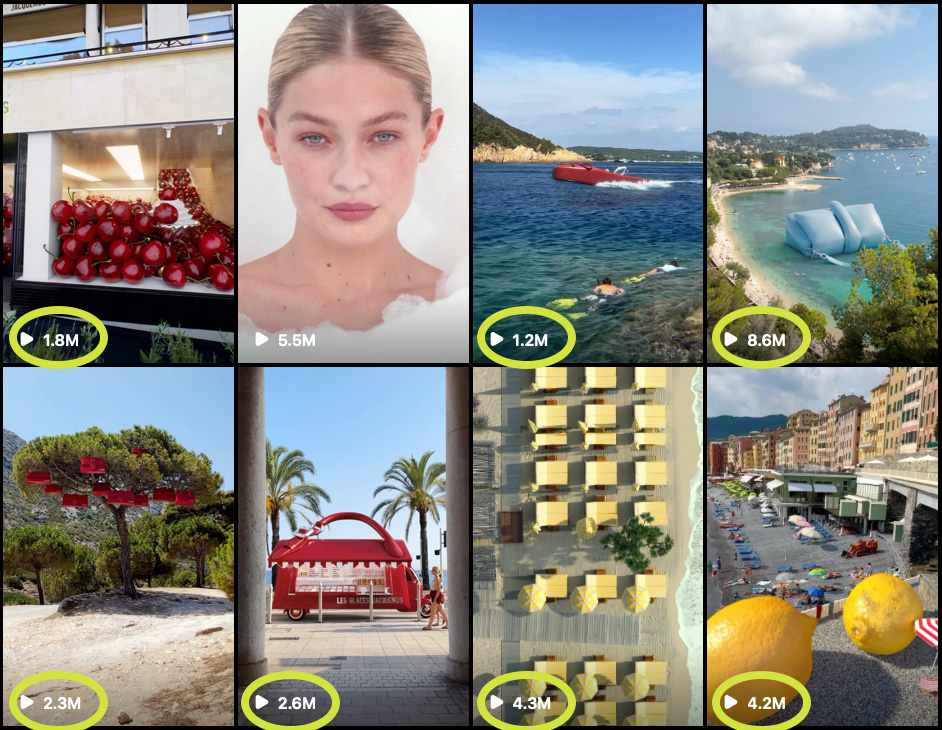
Believe it or not, Fake Out of Home ads are relatively cost-effective compared to traditional out-of-home advertisements such as billboards or bus stop ads. With Fake Out of Home, you don't need to pay for physical space or printing costs; you only need an excellent CGI and video production team.
And with social media platforms offering targeted advertising options, brands can reach their desired audience without spending on expensive billboards that may not even be seen by their target market.
Plus, FOOH ads are a great cost-saving method for testing a new campaign idea or product before investing in a full-scale traditional marketing campaign. Producing a FOOH asset is relatively quick, making it perfect for testing new ideas.
With various short-form content on Instagram Reels, FB shorts, and TikTok competing for views, going viral organically can be challenging. FOOH ads have a wow factor that stays with your viewers, making them more likely to share it with their friends and followers.
Take Alexander Wang's huge FOOH CG installation, for example. It received over 50 million views on Instagram, compared to the hundreds of thousands or several million views of their more normal posts. Going viral means more exposure for your brand and the potential to reach new audiences.
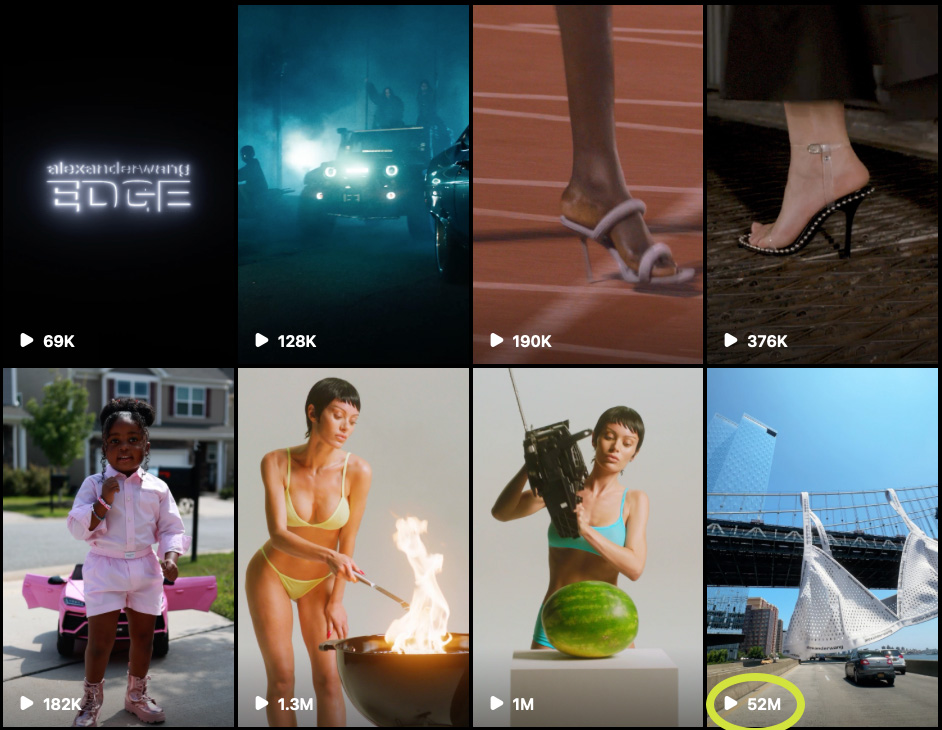
As brands and consumers become more conscious of the impact of consumption on the environment, Fake Out of Home ads offer a more environmentally friendly solution to advertising. With no need for physical materials or space, these ads significantly reduce carbon footprint and waste.
You don't have to fly out your creative team and spend on transportation, accommodations, and production materials to install a physical ad. Plus, with digital tracking and monitoring, brands can easily see the performance of their Fake Out of Home ads in real-time and make adjustments as needed without wasting paper or material.
Your ads also don't need to be reinstalled repeatedly because they were ruined by the weather or vandalized, as it does with more traditional forms of advertising. With the rise of green and sustainable branding, FOOH ads can give your brand a competitive edge.
Fake Out Of Home ads often get negative connotations because of the "Fake" aspect. Some people argue that it's misleading and unethical, while others champion that it's simply a new and creative way for brands to showcase their products.
Another potential consideration is the legality of using certain locations or landmarks in FOOH ads. These ads will often hinge on footage of recognizable locations, and brands must be careful not to infringe on copyrights or trademarks.
You might need to obtain permission or pay licensing fees to use certain locations in your Fake Out Of Home ad campaigns, which is why it's crucial to work with a creative team that truly understands the legalities and best practices of using CGI in advertising.
At rendersnek, we do our homework in researching and obtaining any necessary permissions to ensure your FOOH ads are both effective and ethical. Got a question or an idea? We'd love to hear from you.
FOOH advertising has revolutionized how brands advertise, allowing you to advertise in places where you could never reach before, in ways that traditional advertising could never do. Because of its cost-effectiveness and high-engagement potential, it's no wonder more and more brands are going crazy for this type of advertising and taking a bite out of FOOH pie.
And the numbers don't lie either. FOOH ads have been proven to be more effective in capturing attention and driving engagement than traditional out-of-home forms of advertising. It’s safe to say that this trend is going nowhere and is here to stay, so this is certainly an exciting time for marketers and advertisers to explore the endless possibilities that FOOH ads can offer for their brand.
Our suggestion: Give fake out of home advertisement a try!
To adapt to the ever-evolving way people consume media, fake out of home (FOOH) ads are a new creative phenomenon that has taken the advertising landscape by storm and cemented itself as an incredibly powerful tool for brands.
These ads, also known as "mixed reality videos" or virtual out of home, use cutting-edge technology to place CGI elements into real-life video footage. This creates an immersive and memorable experience for consumers that, when done correctly, can often outperform a brand's usual content and garner millions of views across social media platforms. This is why many brands are jumping on the FOOH advertising craze, hoping to achieve similar success.
With great power, however, comes great responsibility. And while FOOH ads have the potential to be game-changers in your marketing arsenal, they also come with unique challenges that, if not addressed properly, can lead to disastrous results.
In this article, we will explore the common mistakes made in FOOH advertising and how to avoid "Fake Out Of Home Ads Fails", as well as successful examples of brands that did their homework and got it right.
If you're still unsure what FOOH ads are, here's a guide to Fake Out of Home in 2024.

FOOH ads can be an extreme waste of money and effort if not executed correctly. Here are some common FOOH ads fails that sometimes can be overlooked during the production process.
Effective storytelling is a powerful tool in advertising, and this is no different from FOOH advertising. Often, brands get caught up with the shiny new-age technology behind FOOH ads and forget the core of what makes advertising successful – a compelling story.
Without a clear narrative, FOOH ads fails in connecting with the audience and can feel disjointed, and confusing. CGI alone cannot carry a campaign, and brands must ensure that their FOOH ads have a strong, coherent story that resonates with their target audience and shows them the benefits of their product or service.
Tying in with the first FOOH ads fails, a common mistake is when brands lose sight of who they are trying to reach. While it may be tempting to use flashy CGI effects and create a visually impressive ad, it will only achieve its purpose if it connects with the target audience.
For example, a luxury fashion brand targeting affluent consumers would not benefit from using cartoonish CGI elements in its FOOH ads. Instead, focusing on creating a sense of exclusivity and sophistication would be more effective in reaching their target audience.
Extensive research and data analysis are essential to knowing what resonates with your audience. Understanding their interests, behaviors, and preferences will help create FOOH ads that speak directly to them and, in turn, drive better campaign outcomes.
At rendersnek, we pride ourselves on putting the audience at the heart of our FOOH campaigns. When you work with us through the ideation process, we take into account various metrics and insights to ensure your FOOH ad resonates with your intended audience. Contact us to learn more.
FOOH ads rely heavily on seamless integration between real-life footage and CGI elements. Any technical glitches or inconsistencies can immediately make your FOOH ads fails in keeping up the illusion -- and ultimately ruin its impact.
Lighting, for example, is an essential factor that can make or break the believability of FOOH ads. If the lighting and reflections in the real-life footage and CGI elements don't match, it can create jarring differences and distract from the message.
Another example would be the physics within the ad itself. Often the interaction between the CGI and the real-life footage should blend or look realistic. At the end of your ad, your audience should be left wondering, "Did they really do that?" not, "That looks fake."
If you want to learn a more in-depth process and steps for creating fake out-of-home ads, this article explains how to Create Viral Fake out-of-Home Ads.
With how easy it is to go viral in this day and age, it can be tempting to try to replicate the success of others by copying their ideas and concepts. And while this may initially seem like a smart move, it could easily backfire if not done carefully.
Audiences, especially the younger and savvy ones, will quickly catch on when your ad is unoriginal or simply copies another brand's idea. This can lead to a lack of interest and engagement and damage to your brand's authenticity.
Instead, strive for innovation in your FOOH ads. Find unique and creative ways to tell your brand's story and connect with your audience rather than trying to piggyback off the success of others. This will set you apart from competitors and establish your brand as a leader in the industry.
Even with a well-crafted FOOH ad, having a media plan is key. This involves understanding where your target audience spends their time online and effectively placing your ad in front of them.
TikTok, Instagram, YouTube, and even LinkedIn are popular platforms for FOOH advertising, and each has a unique audience demographic. For example, if your target audience is younger users, placing your ad on TikTok would likely be more effective than YouTube shorts.
Fortunately, many audience targeting and optimization tools are available on the market today, so you don't have to do it blindly. The easiest way is to use the insights on your existing channel and check who you are usually reaching and how it differs between platforms.
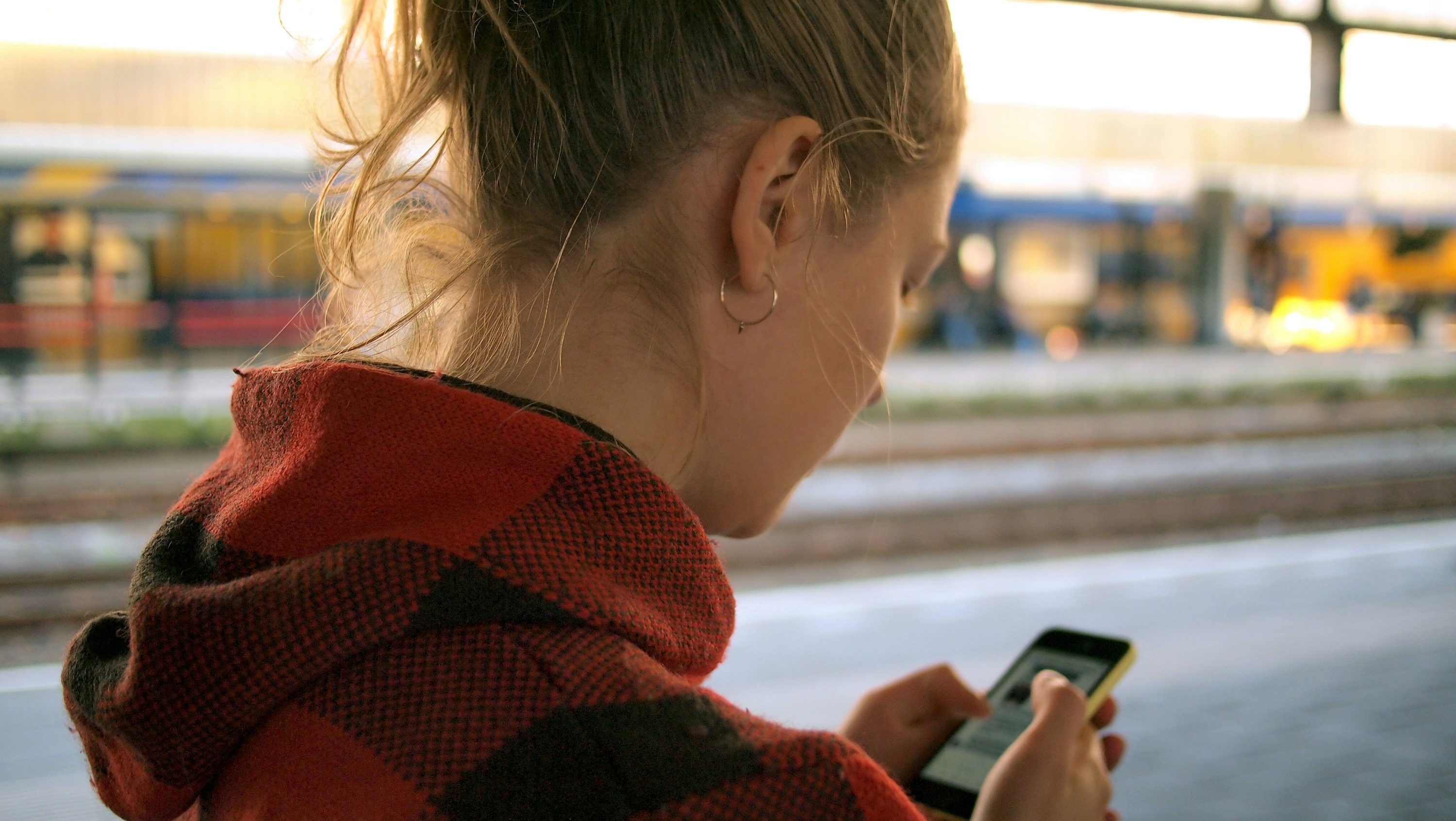
Experience is a great teacher, and learning from others' mistakes can save time, money, and effort in the long run. Here are some tips and strategies to help you avoid common FOOH ads pitfalls.
Before you get caught up in the creative process of FOOH advertising, start by fully understanding who your target audience is. What motivates them? What are their interests and values? Does your audience belong to a specific demographic? Are there any cultural sensitivities or trends that you should be aware of? What would benefit them the most from your product or service?
For example, if you want to promote a productivity app, your target audience might be busy professionals looking for ways to manage their time better. How is your app better than similar ones on the market? What features would be most appealing to your target audience? How can I show all that using a FOOH asset, and where can I reach them—maybe on LinkedIn or other social media platforms?
Answering these questions will help you create a more targeted FOOH ad that speaks directly to your audience's interests and needs. Knowing what resonates with them will increase the chances of your ad being well-received and successful.
The saying goes, "If you fail to plan, you are planning to fail." This is especially true in FOOH advertising. Planning out every aspect of your ad, from the story and visuals to technical details and audience feedback, can help prevent costly mistakes down the line.
Plan the hook of your ad. What will make your audience stop scrolling and pay attention? What will make them stay and finish watching your ad? What emotions do you want to evoke in them? What will make your ad special and not repetitive, something your audience hasn't seen before?
The messaging and planning behind an ad is crucial. When conceptualizing your ad, ask yourself: What is your goal for the ad? Will your ad be part of an extensive campaign or a standalone? Does your message align with your brand's values and mission? What technical specifications and challenges do you need to consider?
You already have the visual nature of the FOOH ad on your side, so use it to your advantage. Show, don't tell. Instead of just putting your product in front of your audience, take them on a journey.
A short ad doesn't mean you can't tell a compelling story. Don't be afraid to get creative, use the power of visuals, music, relatable characters, narration, and humor to craft a narrative that keeps your audience engaged until the last second.
Additionally, ensure your message aligns with your brand's values and is consistent with your overall marketing strategy. Think about what makes your brand unique and how you can use that to tell a story that resonates with your target audience. Is there a problem or pain point that your product or service solves? How does it improve people's lives?
The key is creating a narrative that captures your audience's attention, keeps them hooked until the end, and ultimately leads them to action.
FOOH advertising is a seamless marriage of technology and creativity. So, having a strong technical team in place is crucial to the success of your ad.
These experts should have both the knowledge and experience in CGI and understand the legal and technical aspects of FOOH advertising. They should be able to troubleshoot any technical issues that may arise during the production process and ensure that your ad is compliant with all necessary regulations.
A strong technical team will also help you stay ahead of the curve by incorporating cutting-edge technology and techniques into your FOOH ads, so don't underestimate the importance of technical expertise in FOOH advertising.
Got a question about FOOH ads or already have a concept in mind? Contact us, and let's make it happen!
Your FOOH ad should not exist in a silo. It should be part of a larger marketing strategy and seamlessly integrated with other campaigns you may have running.
For example, if your current social media campaign focuses on building brand awareness, your FOOH ad can serve as a call to action for viewers to follow your page or visit your website. This creates synergy across your campaigns and can increase brand recognition and conversions.
Integrating your FOOH ad with other campaigns also allows for cross-promotion, giving your audience multiple touchpoints to engage with your brand. It's a great way to maximize the impact of all your marketing efforts and drive results.

A good FOOH ad can create a lasting impression and effectively communicate a brand's message to its target audience. Here are some examples of brands that clearly did their homework with FOOH advertising; the results speak for themselves.
1. Zara - "Barbie Collection" - 17.4 million views, 446,000 likes, 2,600 comments, 8,333 shares (on Instagram, July 16, 2023)
In this FOOH ad, Zara used CGI to create an illusion of pink floaties dropping from the sky, with the Empire State Building in the background. The ad ends with a giant pink sign about the Barbie movie, followed by Zara branding.
This ad was released during the week of the Barbie movie’s release. The realism of the floaties set against a recognizable New York City backdrop is a playful, clever way to promote the clothing brand's Barbie collection. And it certainly resonated with their target audience of young, fashion-forward women, receiving over 17 million views on Instagram.
2. F1 - "Silverstone Circuit" - 13.2 million views, 610,000 likes, 1,000 comments, 1,800 shares (on Instagram, February 8, 2024)
This FOOH ad from Silverstone Circuit and F1 is a perfect example of how crucial the marriage of flawless technical expertise, interesting storytelling, and the use of a personal brand is. The ad begins with a Facetime call between British F1 drivers George Rusell and Lando Norris, with the former flipping the camera and showing a gigantic Pirelli tire on the track.
The ad then shows a huge tire slowly rolling on the race track, with a marquee behind it reading "10 more years of Silverstone at Circuit." The ad received over 12 million views, and fans were happy to hear that Silverstone would remain on the race calendar for 10 more years.
3. Samsung - "The Freestyle Smart Projector" - 115,000 views, 4,700 likes, 60 comments, 230 shares (on Instagram, December 7, 2023)
Realism is key in FOOH advertising, and this ad from Samsung just nails it. The ad shows footage of Big Ben and the River Thames at night - with a twist. The ad is for their Freestyle Smart Projector, so the London attraction is seen opening up its gears and the smart projector coming out.
A guy is then shown opening the projector app on his phone. Seconds later, the projector displays a video of Santa and a reindeer skipping across the Thames river, followed by a Happy 2024 message.
An impressive ad, to say the least, this ad is a good lesson on creating a compelling story about your product and using the visuals to make it pop. And it doesn't look easy to make either, with the footage filmed during nighttime, which surely made incorporating CGI elements a technical challenge. But it was well worth it, with over 100k views on Instagram and many users applauding Samsung for how unique and creative the ad was.
4. Pull&Bear - Gift Card - 1.6 million views, 20,400 likes, 50 comments, 60 shares (on Instagram, November 22, 2023)
A strong hook and narrative that draws viewers in is crucial if you want your FOOH ad to succeed, especially for something as simple as gift cards. And that's precisely what Pull&Bear did. The ad shows a sequence of life-sized gift cards in Los Angeles, California, falling down one after the other, creating a domino effect.
Starting on top of a building, the effect makes its way down the street—almost hitting a pedestrian crossing the street—before it eventually topples down a tower of green Pull&Bear gift cards. The ad ends with a slo-mo of one of the gift cards to show the Pull&Bear branding before eventually falling onto the pavement.
This FOOH is a perfect example of how you can create a compelling story around any product or service. The ad is visually engaging, full of energy, showcases the brand's signature green color, and perfectly aligns with the brand's image.
Having almost 1.6 million on Instagram, it's safe to say that the ad effectively showcased Pull&Bear's gift cards as something fun and exciting — exactly what they were going for.
5. Volvo - Luxury Without the Bling Bling - 934,000 views, 12,900 likes, 80 comments, 172 shares (on Instagram, March 13, 2024)
Your FOOH ad doesn't always have to announce something huge or promote an upcoming event; sometimes, it can be as subtle as showcasing your brand's values and image. This ad from Volvo does precisely that.
The viewer first sees a hand holding a car key. After turning it on, a sleek black Volvo car tunnels through an underground driveway. We then see a garage door with the Volvo logo on the second story of a building opening up, revealing the car. The ad ends with the message marquee that reads (in German), "Luxury without the bling-bling (Unless the bling-bling increases security at some point).”
This ad perfectly represents Volvo's brand image of elegance, luxury, and simplicity. It highlights what the brand stands for without being too flashy or over-the-top while still showing that it doesn’t take itself too seriously. The message shows that Volvo doesn't need to rely on flashy features or gimmicks; its cars speak for themselves. And with almost a million views on Instagram, this ad demonstrates that your FOOH ad can be both subtle and effective.
6. Benefit Cosmetics - Benetint Cheek & Lip Stain - 1.6 million views, 20,400 likes, 50 comments, 60 shares (on Instagram, November 22, 2023)
A successful FOOH advert is all about a good blend of creativity, storytelling, and clever use of technology. Check out this ad for Benefit Cosmetics Benetint Cheek & Lip Stain, where reality and technology work hand in hand to showcase the product in a busy cityscape.
The ad shows a massive bottle of the product displayed on the rainy streets of San Francisco, with life-sized jello-like blobs coming out of it, bouncing onto the street, and floating into the sky. One of the blobs hits a woman's umbrella as she passes by, causing a part of the umbrella to turn pink, showcasing the product's color. One also hits a building window as it floats, turning it pink.
This cheeky (pun intended) FOOH ad perfectly demonstrates the product's unique feature - it's a stain that can be used on both cheeks and lips. And with over 1.4 million views on Instagram, it's safe to say that this ad was a hit among Benefit Cosmetics' target audience.
FOOH advertising can be a powerful and effective tool in your marketing arsenal, as long as you do it right. Understanding your target audience, planning meticulously, telling a compelling story, and having a strong technical team are all essential elements of a successful FOOH ad.
Be creative, take risks, and stay true to your brand's values, and you'll see the results in increased engagement, brand awareness, and ultimately, sales. Keep these tips in mind when trying out a FOOH advertising and if you need some help feel free to contact us at any time.
Making a good ad in general is already an art in itself, from knowing who you’re selling to and making it emotionally appealing to the timing and placement of an ad.
I don't wish to delve deeply into advertising in general; there are many more experts available for that. Today I want to take you on the journey of how we can make amazing fake out of home Ads (FOOH Ads).
Here’s a brief definition: Fake Out Of Home Ads are Ads that combine actual video footage with 3D elements, mostly showcasing a product in an absurd, close to reality, way.
In 2023 every week another FOOH Ad (also known as FAUX OOH) has gone viral. As of december 2023 a decent amounts of big brands like, Adidas, Samsung, Lenovo, Maybelline and even Apple jumped on this trend.
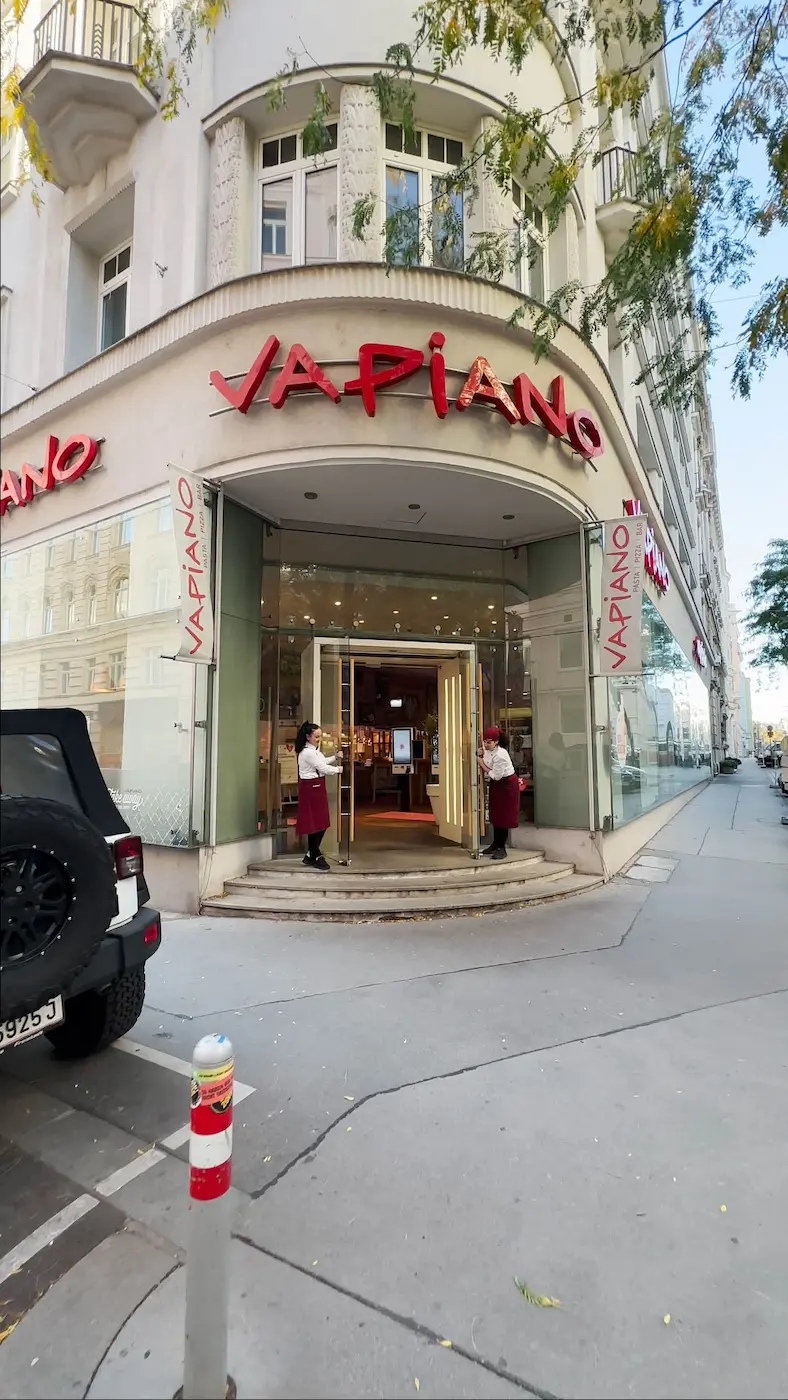
Without 3D-Elements
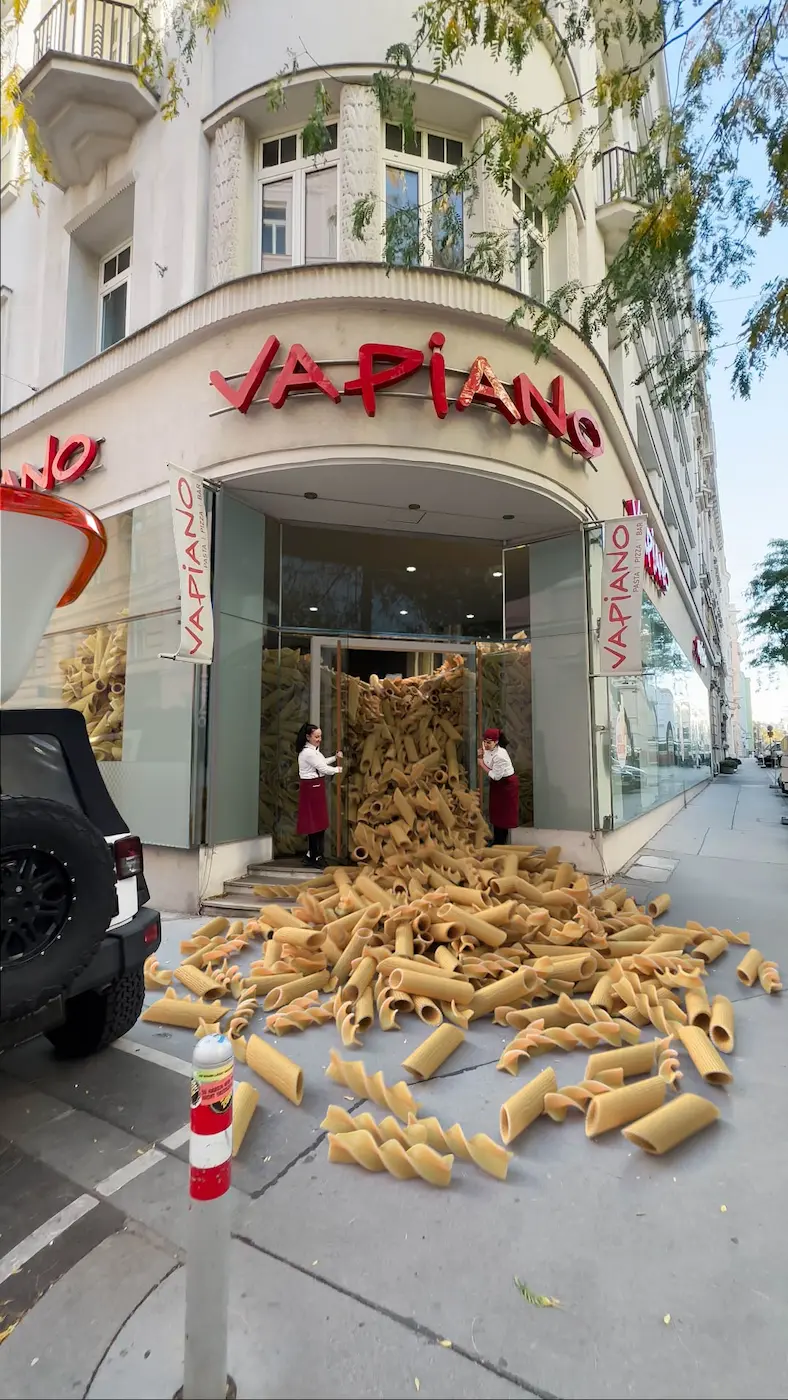
With 3D-Elements
What goes for every advertisement also counts for Fake Out Of Home Ads. People want creativity and originality. No matter if you’re an artist or a brand. It's worth spending a couple more hours on planning and designing the concept; it might take a surprising turn and end up going viral.
Strong visuals and effective design saturate social media, demanding that you distinguish yourself to truly make an impact. Use the first 1-3 seconds to grab the users attention by setting up the hook. Moreover spend time on details. Shadows, reflections, lighting and poor rotoscoping will give your video away although people won’t be able to put a finger on it. You don’t want your audience wandering what’s wrong with the video, you want them to be stunned and wonder how this looks so real, while knowing it’s not.
2,4+ Mio Views, 40k Likes, 600+ comments and 2,8k Shares.
Understanding the viral potential of your Fake Out of Home Ads is paramount to their success. Consider this as the secret sauce that can propel your content to the far reaches of the internet. Viral potential isn't just a matter of luck; it's a calculated aspect of your FOOH Ads strategy. During the concept phase, invest time in dissecting your content and identifying what could make it go viral. Is it an emotionally stirring narrative, an unexpected twist, or a story that resonates with a broad audience? Perhaps it's a jaw-dropping visual effect that leaves viewers in awe. Deliberately place these elements within your video, strategically build up to them, or unleash them right from the beginning. Remember, while there's always a bit of luck involved in virality, meticulous planning and attention to the factors that drive sharing can significantly boost your FOOH Ads' chances of becoming the next internet sensation.
Now that we discussed the key elements of successful fake out of home ads, let’s walk through the process of creating one - or at least how we at rendersnek work.
Idea generation and brainstorming
It all starts with a meeting of the two parties - 3d animation studio & you - especially if there’s no idea existing yet. Understanding your needs and your clients needs is essential for the whole project. Based on the first briefing, briefingmaterial and some basic online research, the brainstorming process starts. Either with you or internally. Once we decided on an idea we move on to the next step.
Shoot the Video
Ensuring a hassle-free and legally sound video shoot is our priority. There is some rather small stuff you need to pay attention to, like not messing with copyrights and defamation of other parties. If you work with us, we'll provide you with all the essential information.
Besides that, as already mentioned, the base of all FOOH Ads are regular videos. Think about what format (16:9, 9:16 or 4:3) and what resolution (Full HD, 4K) you want it to be - that will already make a difference in how the video is being shot.
Creation
Every fake out of home ad creation starts with the tracking of the videofootage. That basically means that we recreate the camera movement of the videographer in a virtual space. This allows us to recreate the surroudings in a virtual scene, that represents what we see in the videofootage, and put 3D objects in there. Adjusting lighting, materials and reflections is where the reality comes in. Especially lighting makes 80% of a realistic scene/ object. In the end everything is being composited together (called 3d compositing), part of the could be to set objects free and layer them on top of your CGI installation to create another level of reality. É voila you got your FOOH Ad.
While there's still significant manual work involved (not AI driven yet), we've omitted some complexities in the explanation to keep things clear and accessible, ensuring that we handle all the heavy lifting for you. If you have any question don’t hesitate to contact us for more information.
Something that is not being discussed too much about is the ethical consideration of fake out of home ads. This is a huge topic will be discussed in a seperate article, but for now note that a lot of public buildings have a historical background, so think twice if you want to alter or play with this building. When you work with us, we do this research for you.
The buzz around Fake Out of Home Ads is undeniable in the marketing world, but will this trend stand the test of time? We anticipate it will remain a dominant force in advertising for at least another year.
As with any trend, it will evolve, and the initial viral excitement may wane. However, this presents exciting opportunities for 3D animation studios and artists to explore new and innovative creative avenues.
Brands like Samsung are already pioneering fresh approaches to FOOH Ads, showcasing their products uniquely. The future of FOOH Ads holds promise and limitless creativity, with brands and artists continually captivating audiences with remarkable content.
To sum it up, Fake Out of Home Ads (FOOH Ads) are going viral all over social media, due to their creative and attention-grabbing nature. These ads combine real video footage with imaginative 3D elements to showcase products in unique ways.
Certain key elements, like creativity, strong visuals, and relevance to the audience, makes them stand out and go viral. Companies and artists working on these ads must also consider ethical aspects when altering public places.
We believe that FOOH Ads will remain popular for at least another year and will become an essential part in the world of advertising in the future.
We are convinced that Fake Out Of Home Ads offer exciting opportunities for creative minds to explore new ideas.
So, keep an eye out for these impressive ads and the creativity they bring to advertising, as FOOH Ads are here to stay, offering endless possibilities for engaging audiences. If you want to see more examples check out this article.
If your ads are no longer getting the retention that you need, you might wish to switch up the way you’re doing things.
That’s what Vapiano CGI Video advert did.
The result?
400,000 views within the first few hours.
And that is what made World Pasta Day a moment to remember!
…
Old-fashioned advertising doesn't work well anymore because technology keeps changing. Brands that want to sell things should work with creative agencies that can keep up with new trends.
In today's fast-paced (advertising) world, capturing and holding a viewer's attention has become an art. It's a skill that demands focus, storytelling, and captivating visuals to keep eyes glued to screens.
So, if you’re wanting 2+ mio. unique views on your next advert, maybe the following insights of our project with Vapiano in collaboration with Traktor Wien agency will help.
In one sentence: Consistently showing up on social media.
Especially as a very young company with little connections in the marketing world, it is not easy to find clients. It’s so competitive that you need something unique. Something that shows you care about the work you do - in our case mostly "Fake Out Of Home Videos".
Our social media tactic: posting once a week, interacting with agencies and brands, try new stuff and not just have a portfolio page.
So, showing up on social media eventually lead, Traktor Wien Agency, whos motto is to do advertising for people who actually don’t like advertising, to our Instagram page and that’s how we ended up getting a good old email in our inbox.
After one or two weeks of DMs sharing ideas, a vision for celebrating World Pasta Day took shape. Vapiano's dream of creating an eye-catching advertisement became a reality.
Challenge 1: Attention
Grabbing attention in the first 1.5 seconds is a known fact to everyone who does social media.
Otherwise, attention is gone, and every click or action associated with it is also gone and of course so is the revenue it brings.
So, to grab the attention in the first place, things needed to happen, a lot of things. At first the viewer can spot the car with a gigantic vapiano take away box on the roof. Then you notice two people walking in from the left side, pointing at the facade, which was filled with hyperdimensional spaghetti.
And last but not least, it’s not enough to grab the attention, you also want to hold it. So as soon as the viewer is done with checking out the façade, the two vapianisti are already opening the double door to reveal an avalanche of penne and fusilli.
Challenge 2: Environment
Since the video was shot in a busier street (almos Mariahilferstraße), we already needed to pick a timeframe where there’s little people, but also where we would have a nice lighting. We checkout the place in different times of the day and decided for the morning between 8:00 am and 9:00 am. Everything seemed perfecet on the day of the shooting, but there is always something that you don’t have influence on. In our case that bulky jeep, that was parked in front of the building. Which was of course not exactly what we wanted when we first started filming.
Whilst it wasn’t ideal, we had to use our surroundings to our advantage and create storyboards based on everything around us – this is how we came up with the gigantic takeaway box infront of the building.
Challenge 3: Food
As already mentioned, the probably biggest challenge was to stage the food in a way, that the viewers first thought isn’t – “yuck, there’s food on the street”.
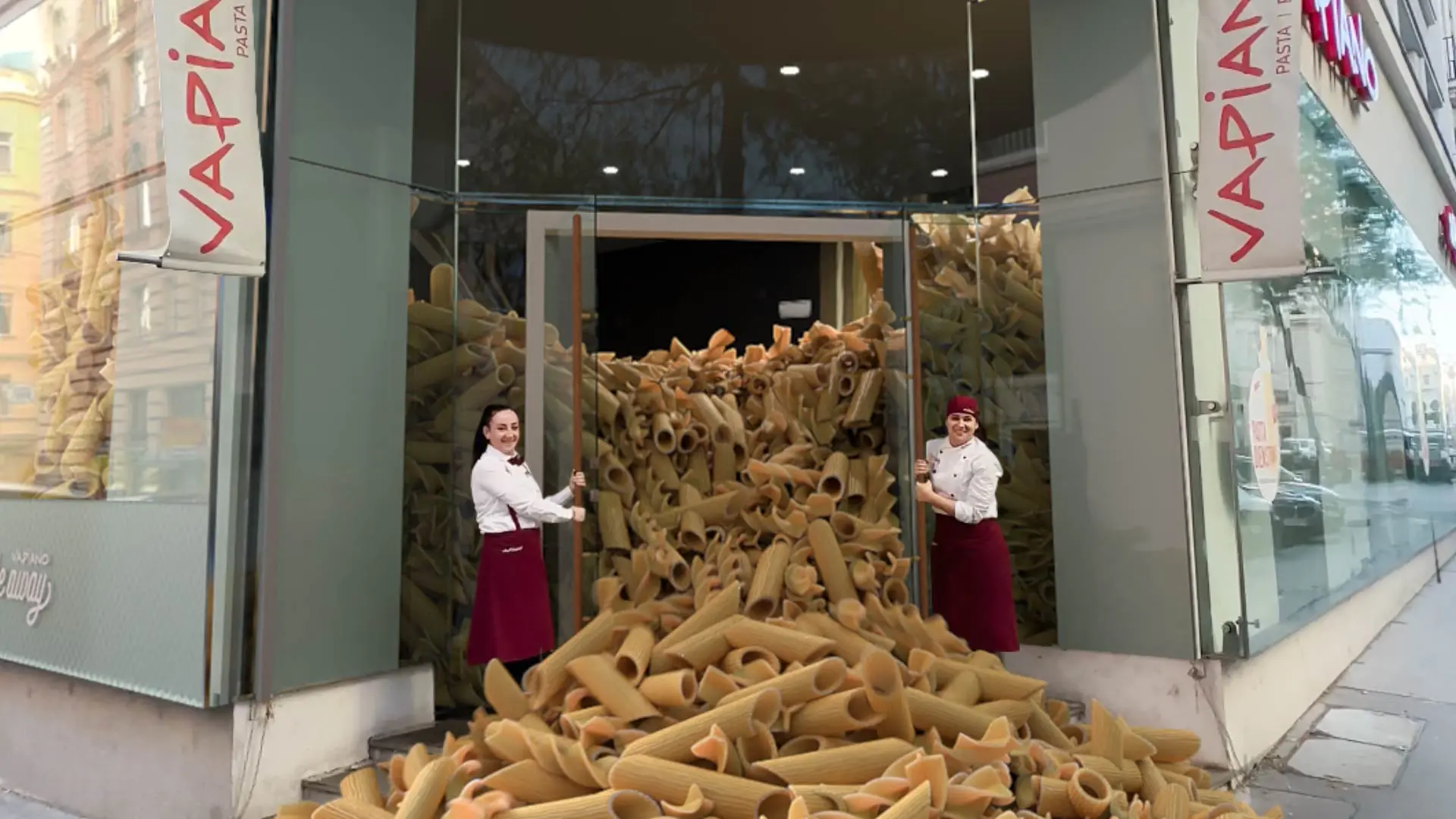
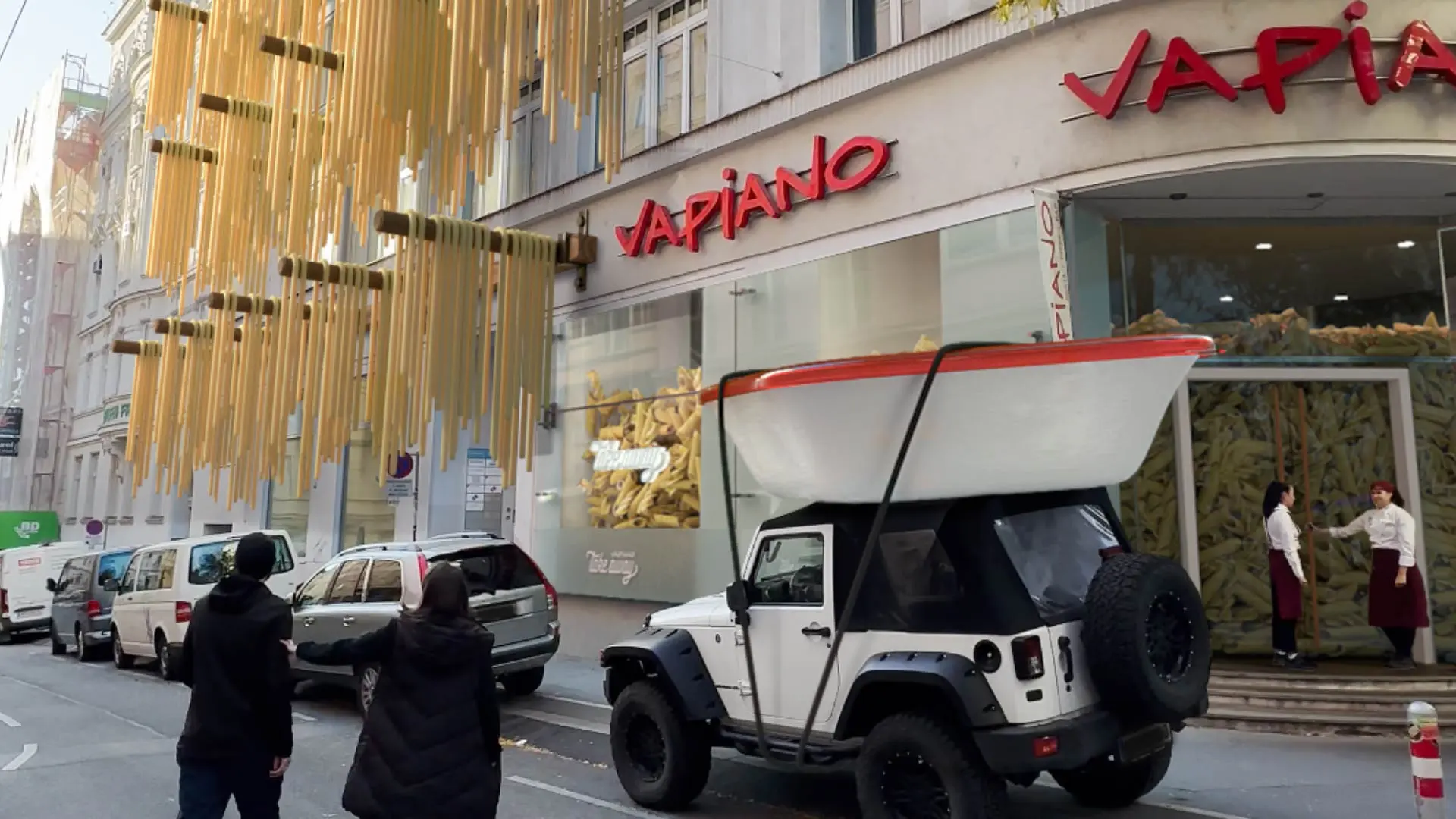
And so, we had to ensure that the fusilli-penne-avalanche simulation looked appetizing, which already was a challenge, because nobody ever saw a pasta avalanche of this size.
Challenge 4: Actors
The last challenge was the human challenge, because when you shoot the video, nothing is there yet. The actors need to understand what will happen in the after production and where everything will be placed. So it’s crucial to have a very detailed idea of what will happen, because you can change pretty much everything in the video, but the reaction of the humas to it is something that can’t be changed.
Our guess is a combination of the many impressions the viewer already has in the first 2 seconds, plus the fact that nobody had ever seen a scene like that before. A fun, entertaining video that invited people to come to the restaurant. It didn’t even feel like an ad.
Rendersnek's collaboration with Traktor Wien Agency for Vapiano's World Pasta Day campaign is a prime example of how CGI can be effectively integrated the advertising industry.
As the world of advertising evolves, standing out becomes crucial. It is understanding what captures attention and keeps viewers engaged that helps to make purchase decisions.
The combination of CGI, reality and attention to detail can turn an everyday scene into a spectacle.
As the lines blur between reality and CGI, this project exemplifies the boundless creativity of the advertising world, turning the ordinary into the extraordinary.